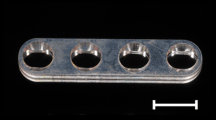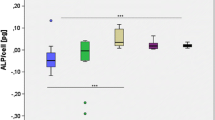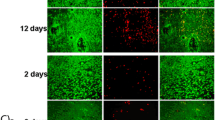Abstract
Purpose
In recent decades operative fracture treatment using elastic stable intramedullary nails (ESINs) has mainly taken precedence over conservative alternatives in children. The development of biodegradable materials that could be used for ESINs would be a further step towards treatment improvement. Due to its mechanical and elastic properties, magnesium seems to be an ideal material for biodegradable implant application. The aim of this study was therefore to investigate the cellular reaction to biodegradable magnesium implants in vitro.
Methods
Primary human growth plate chondrocytes and MG63 osteoblasts were used for this study. Viability and metabolic activity in response to the eluate of a rapidly and a slower degrading magnesium alloy were investigated. Furthermore, changes in gene expression were assessed and live cell imaging was performed.
Results
A superior performance of the slower degrading WZ21 alloy’s eluate was detected regarding cell viability and metabolic activity, cell proliferation and morphology. However, the ZX50 alloy’s eluate induced a favourable up-regulation of osteogenic markers in MG63 osteoblasts.
Conclusions
This study showed that magnesium alloys for use in biodegradable implant application are well tolerated in both osteoblasts and growth plate chondrocytes respectively.






Similar content being viewed by others
References
Ligier JN, Metaizeau JP, Prévot J (1983) Closed flexible medullary nailing in pediatric traumatology. Chir Pediatr 24(6):383–385
Simanovsky N, Tair MA, Simanovsky N, Porat S (2006) Removal of flexible titanium nails in children. J Pediatr Orthop 26(2):188–192
Huan ZG, Leeflang MA, Zhou J, Fratila-Apachitei LE, Duszczyk J (2010) In vitro degradation behavior and cytocompatibility of Mg-Zn-Zr alloys. J Mater Sci Mater Med 21(9):2623–2635
Staiger MP, Pietak AM, Huadmai J, Dias G (2006) Magnesium and its alloys as orthopedic biomaterials: a review. Biomaterials 27(9):1728–1734
Witte F, Hort N, Vogt C, Cohen S, Kainer KU, Willumeit R, Feyerabend F (2008) Degradable biomaterials based on magnesium corrosion. Curr Opin Solid State Mater Sci 12(5–6):63–72
Claes LE (1992) Mechanical characterization of biodegradable implants. Clin Mater 10(1–2):41–46
Hänzi AC, Gerber I, Schinhammer M, Löffler JF, Uggowitzer PJ (2010) On the in vitro and in vivo degradation performance and biological response of new biodegradable Mg-Y-Zn alloys. Acta Biomater 6(5):1824–1833
Yu K, Chen L, Zhao J, Li S, Dai Y, Huang Q, Yu Z (2012) In vitro corrosion behavior and in vivo biodegradation of biomedical β-Ca3(PO4)2/Mg-Zn composites. Acta Biomater 8(7):2845–2855
Krause A, Höh N, Bormann D, Krause C, Bach F-W, Windhagen H, Meyer-Lindenberg A (2010) Degradation behaviour and mechanical properties of magnesium implants in rabbit tibiae. J Mater Sci 45(3):624–632
Witte F, Kaese V, Haferkamp H, Switzer E, Meyer-Lindenberg A, Wirth CJ, Windhagen H (2005) In vivo corrosion of four magnesium alloys and the associated bone response. Biomaterials 26(17):3557–3563
Castellani C, Lindtner RA, Hausbrandt P, Tschegg E, Stanzl-Tschegg SE, Zanoni G, Beck S, Weinberg AM (2011) Bone-implant interface strength and osseointegration: biodegradable magnesium alloy versus standard titanium control. Acta Biomater 7(1):432–440
Pourbaix M (1974) Atlas of electrochemical equilibria in aqueous solutions. National Association of Corrosion Engineers, Houston
Kraus T, Fischerauer SF, Hänzi AC, Uggowitzer PJ, Löffler JF, Weinberg AM (2012) Magnesium alloys for temporary implants in osteosynthesis: in vivo studies of their degradation and interaction with bone. Acta Biomater 8(3):1230–1238
Gu X, Zheng Y, Zhong S, Xi T, Wang J, Wang W (2010) Corrosion of, and cellular responses to Mg-Zn-Ca bulk metallic glasses. Biomaterials 31(6):1093–1103
Lu P, Cao L, Liu Y, Xu X, Wu X (2011) Evaluation of magnesium ions release, biocorrosion, and hemocompatibility of MAO/PLLA-modified magnesium alloy WE42. J Biomed Mater Res B Appl Biomater 96(1):101–109
Chung R, Foster BK, Xian CJ (2011) Injury responses and repair mechanisms of the injured growth plate. Front Biosci (Schol Ed) 3:117–125
Davies JH, Evans BA, Jenney ME, Gregory JW (2002) In vitro effects of chemotherapeutic agents on human osteoblast-like cells. Calcif Tissue Int 70(5):408–415
Pichler K, Schmidt B, Fischerauer EE, Rinner B, Dohr G, Leithner A, Weinberg AM (2012) Behaviour of human physeal chondro-progenitorcells in early growth plate injury response in vitro. Int Orthop 36(9):1961–1966
Lefebvre V, Peeters-Joris C, Vaes G (1990) Production of collagens, collagenase and collagenase inhibitor during the dedifferentiation of articular chondrocytes by serial subcultures. Biochim Biophys Acta 1051(3):266–275
Chacko S, Abbott J, Holtzer S, Holtzer H (1969) The loss of phenotypic traits by differentiated cells. VI. Behavior of the progeny of a single chondrocyte. J Exp Med 130(2):417–442
Coon HG (1966) Clonal stability and phenotypic expression of chick cartilage cells in vitro. Proc Natl Acad Sci U S A 55(1):66–73
Lefebvre V, Smits P (2005) Transcriptional control of chondrocyte fate and differentiation. Birth Defects Res C Embryo Today 75(3):200–212
Gerstenfeld LC, Shapiro FD (1996) Expression of bone-specific genes by hypertrophic chondrocytes: implication of the complex functions of the hypertrophic chondrocyte during endochondral bone development. J Cell Biochem 62(1):1–9
Gu XN, Xie XH, Li N, Zheng YF, Qin L (2012) In vitro and in vivo studies on a Mg-Sr binary alloy system developed as a new kind of biodegradable metal. Acta Biomater 8(6):2360–2374
Zhou WR, Zheng YF, Leeflang MA, Zhou J (2013) Mechanical property, biocorrosion and in vitro biocompatibility evaluations of Mg-Li-(Al)-(RE) alloys for future cardiovascular stent application. Acta Biomater 9(10):8488–8498
Del Gaudio C, Bagalà P, Venturini M, Grandi C, Parnigotto PP, Bianco A, Montesperelli G (2012) Assessment of in vitro temporal corrosion and cytotoxicity of AZ91D alloy. J Mater Sci Mater Med 23(10):2553–2562
Cipriano AF, Zhao T, Johnson I, Guan RG, Garcia S, Liu H (2013) In vitro degradation of four magnesium-zinc-strontium alloys and their cytocompatibility with human embryonic stem cells. J Mater Sci Mater Med 24(4):989–1003
Feyerabend F, Witte F, Kammal M, Willumeit R (2006) Unphysiologically high magnesium concentrations support chondrocyte proliferation and redifferentiation. Tissue Eng 12(12):3545–3556
Feser K, Kietzmann M, Bäumer W, Krause C, Bach FW (2011) Effects of degradable Mg-Ca alloys on dendritic cell function. J Biomater Appl 25(7):685–697
Feyerabend F, Fischer J, Holtz J, Witte F, Willumeit R, Drücker H, Vogt C, Hort N (2010) Evaluation of short-term effects of rare earth and other elements used in magnesium alloys on primary cells and cell lines. Acta Biomater 6(5):1834–1842
Li J, Song Y, Zhang S, Zhao C, Zhang F, Zhang X, Cao L, Fan Q, Tang T (2010) In vitro responses of human bone marrow stromal cells to a fluoridated hydroxyapatite coated biodegradable Mg-Zn alloy. Biomaterials 31(22):5782–5788
Li L, Gao J, Wang Y (2004) Evaluation of cyto-toxicity and corrosion behavior of alkali-heat-treated magnesium in simulated body fluid. Surf Coat Technol 185(1):92–98
Pietak A, Mahoney P, Dias GJ, Staiger MP (2007) Bone-like matrix formation on magnesium and magnesium alloys. J Mater Sci Mater Med 19(1):407–415
Witte F, Feyerabend F, Maier P, Fischer J, Störmer M, Blawert C, Dietzel W, Hort N (2007) Biodegradable magnesium-hydroxyapatite metal matrix composites. Biomaterials 28(13):2163–2174
Yang C, Yuan G, Zhang J, Tang Z, Zhang X, Dai K (2010) Effects of magnesium alloys extracts on adult human bone marrow-derived stromal cell viability and osteogenic differentiation. Biomed Mater 5(4):045005
Zhang S, Li J, Song Y, Zhao C, Zhang X, Xie C, Zhang Y, Tao H, He Y, Jiang Y, Bian Y (2009) In vitro degradation, hemolysis and MC3T3-E1 cell adhesion of biodegradable Mg–Zn alloy. Mater Sci Eng C 29(6):1907–1912
Zreiqat H, Howlett CR, Zannettino A, Evans P, Schulze-Tanzil G, Knabe C, Shakibaei M (2002) Mechanisms of magnesium-stimulated adhesion of osteoblastic cells to commonly used orthopaedic implants. J Biomed Mater Res 62(2):175–184
Zreiqat H, Valenzuela SM, Nissan BB, Roest R, Knabe C, Radlanski RJ, Renz H, Evans PJ (2005) The effect of surface chemistry modification of titanium alloy on signalling pathways in human osteoblasts. Biomaterials 26(36):7579–7586
Coleman JE (1992) Structure and mechanism of alkaline phosphatase. Annu Rev Biophys Biomol Struct 21:441–483
Lee NK, Sowa H, Hinoi E, Ferron M, Ahn JD, Confavreux C, Dacquin R, Mee PJ, McKee MD, Jung DY, Zhang Z et al (2007) Endocrine regulation of energy metabolism by the skeleton. Cell 130(3):456–469
Gu XN, Li N, Zhou WR, Zheng YF, Zhao X, Cai QZ, Ruan L (2011) Corrosion resistance and surface biocompatibility of a microarc oxidation coating on a Mg-Ca alloy. Acta Biomater 7(4):1880–1889
Michalke B, Halbach S, Nischwitz V (2009) JEM spotlight: metal speciation related to neurotoxicity in humans. J Environ Monit 11(5):939–954
Drynda A, Deinet N, Braun N, Peuster M (2009) Rare earth metals used in biodegradable magnesium-based stents do not interfere with proliferation of smooth muscle cells but do induce the upregulation of inflammatory genes. J Biomed Mater Res A 91(2):360–369
Hirano S, Suzuki KT (1996) Exposure, metabolism, and toxicity of rare earths and related compounds. Environ Health Perspect 104(Suppl 1):85–95
Wells WH Jr, Wells VL (2012) The lanthanides, rare earth metals. In: Bingham E, Cohrssen B (eds) Patty’s toxicology. Wiley, Hoboken
Acknowledgments
The authors appreciate support from the Laura Bassi Center of Expertise BRIC (Bioresorbable Implants for Children; FFG – Austria) and from the Staub/Kaiser Foundation, Switzerland. Furthermore, they would like to thank Mr. Rudolf Schmied for his valuable technical assistance in art work preparation and Ms. Aranka Schauer for her help in carrying out some of the experiments.
Author information
Authors and Affiliations
Corresponding author
Additional information
Karin Pichler and Tanja Kraus contributed equally to this work.
Electronic supplementary material
Below is the link to the electronic supplementary material.
Table 1
Concentrations of chemical substances used for the SBF (concentrations are indicated in mmol/L). (DOC 33.5 kb)
Table 2
Element concentration after 48 h of implant incubation given in mg/ml SBF. (DOC 39.5 kb)
Videos show the investigated cells treated with the different alloys’ eluates, SBF and untreated control cells during an incubation period of 48 h.
hGPC treated with the ZX50 eluate. (MPEG 2.66 MB)
hGPC treated with the WZ21 eluate. (MPEG 2.64 MB)
hGPC treated with SBF. (MPEG 2.35 MB)
Untreated hGPC. (MPEG 2.30 MB)
MG63 osteoblasts treated with the ZX50 eluate. (MPEG 2.70 MB)
MG63 osteoblasts treated with the WZ21 eluate. (MPEG 2.71 MB)
MG63 osteoblasts treated with SBF. (MPEG 2.71 MB)
Untreated MG63 osteoblasts. (MPEG 2.64 MB)
Rights and permissions
About this article
Cite this article
Pichler, K., Kraus, T., Martinelli, E. et al. Cellular reactions to biodegradable magnesium alloys on human growth plate chondrocytes and osteoblasts. International Orthopaedics (SICOT) 38, 881–889 (2014). https://doi.org/10.1007/s00264-013-2163-3
Received:
Accepted:
Published:
Issue Date:
DOI: https://doi.org/10.1007/s00264-013-2163-3




